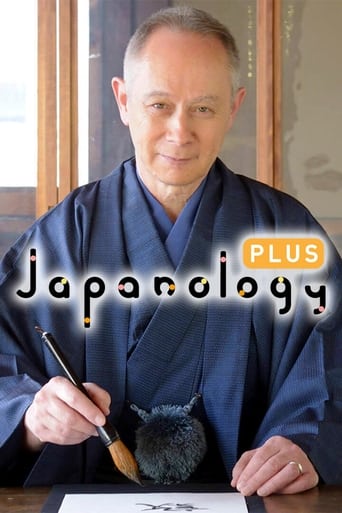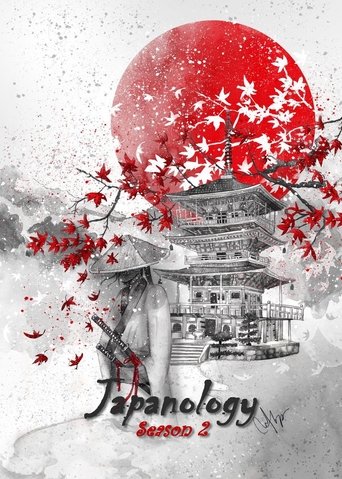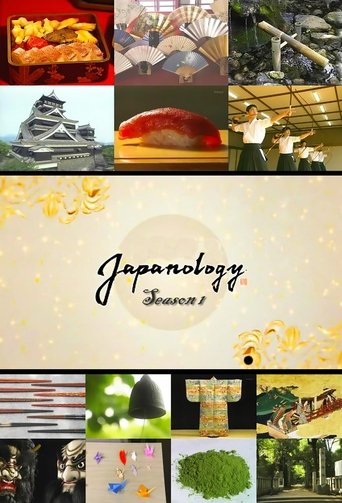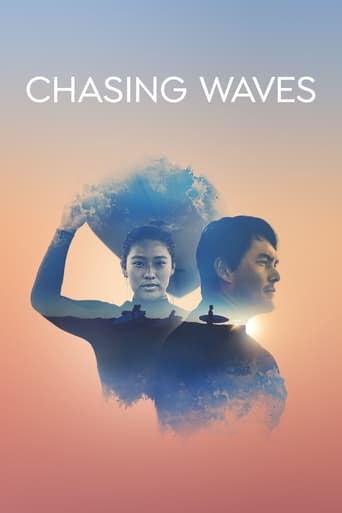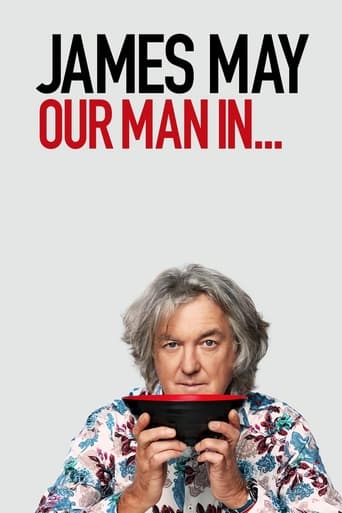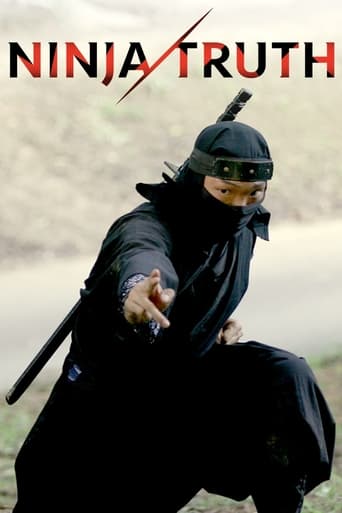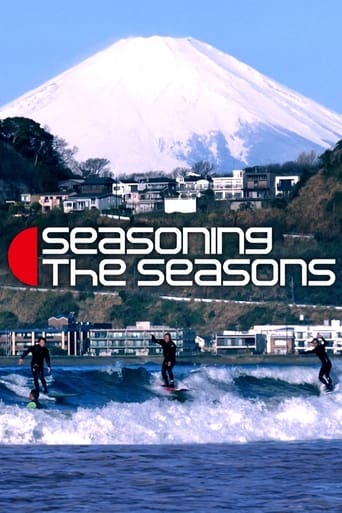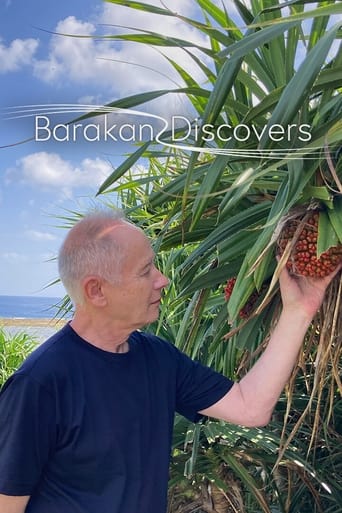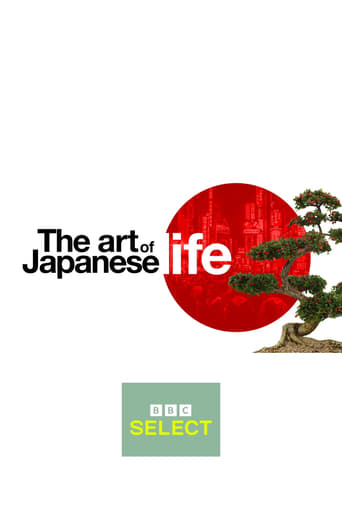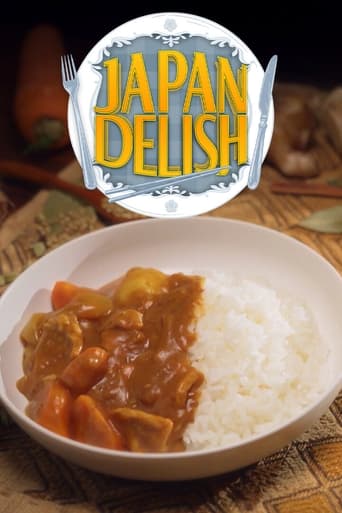Japanology Plus Season 5
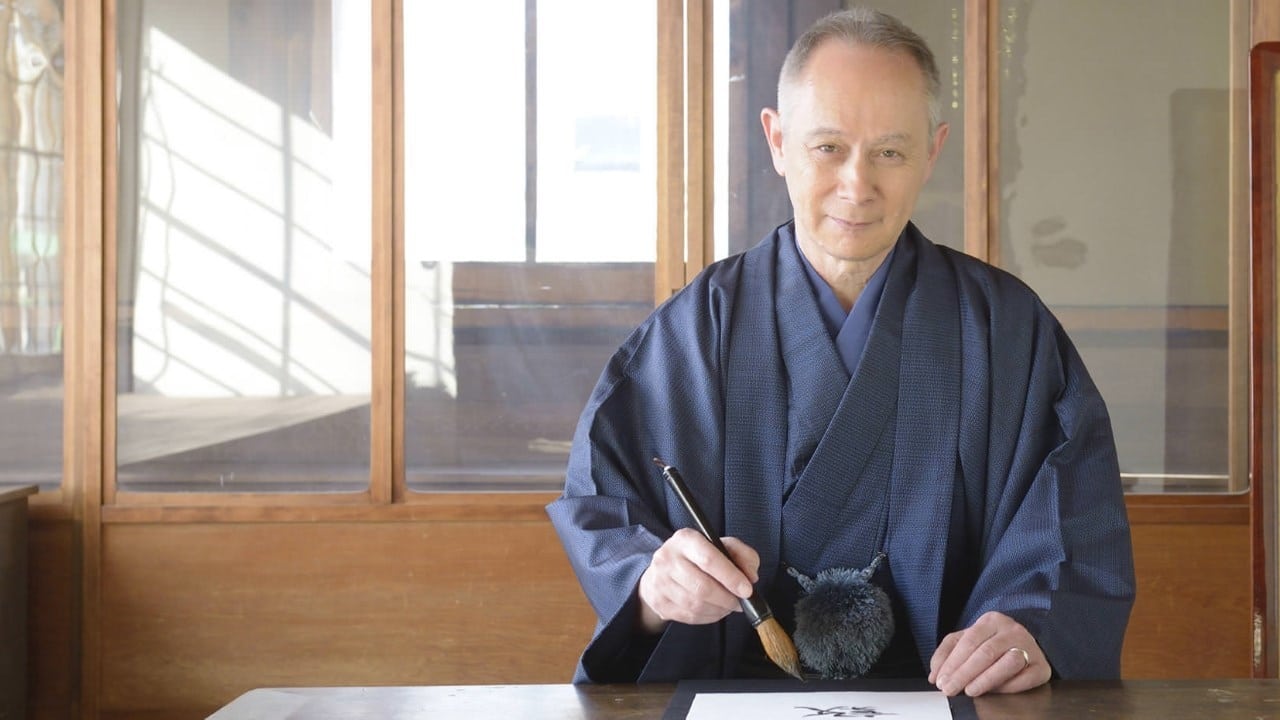
Host Peter Barakan delves into various aspects of Japanese culture; exploring practices, history, and modern innovations in such areas as ramen, rice, sushi, geisha, bonsai, and so much more. Local experts discuss their passions at fascinating length, and American Japanophile Matt Alt experiences the food, practices, and cultures in each episode in depth. Viewers will finish each half hour episode with a new understanding of an area of Japanese life through demonstrative videos and explanations, all delivered respectfully and true to the Japanese way of life.
Watch NowWith 30 Day Free Trial!
Japanology Plus
2014 / NR
Host Peter Barakan delves into various aspects of Japanese culture; exploring practices, history, and modern innovations in such areas as ramen, rice, sushi, geisha, bonsai, and so much more. Local experts discuss their passions at fascinating length, and American Japanophile Matt Alt experiences the food, practices, and cultures in each episode in depth. Viewers will finish each half hour episode with a new understanding of an area of Japanese life through demonstrative videos and explanations, all delivered respectfully and true to the Japanese way of life.
Watch Trailer
With 30 Day Free Trial!
Japanology Plus Season 5 Full Episode Guide
Soba, or buckwheat noodles, are served everywhere in Japan. But soba is more than just a food; it's also an auspicious way to end the year. This time on Japanology Plus, our theme is soba restaurants. Our main guest is Kyo Amemiya, editor-in-chief of a publishing company that specializes in cooking and food books. He introduces us to a variety of soba restaurants and points out some interesting takes on this classic dish. And in Plus One, Matt Alt learns about some amazing food delivery methods.
Uniforms are a familiar sight in Japan, whether it’s the jacket of a taxi driver, or the black suit of a new office worker. Among the most visible examples are the uniforms worn by middle and high school students. They often feature distinctive collars and buttons, originally based on naval or army clothing. This time on Japanology Plus, our theme is school uniforms. Our main guest, university professor Mami Bamba, explains what these outfits can tell us about Japanese society. And in Plus One, Matt Alt designs a brand-new school uniform.
2018 marks the 150th year since the beginning of the Meiji era, as well as the end of the age of samurai in Japan. Meiji means “Enlightened Rule,” and the era lasted from 1868 until 1912. The ultimate objective at the time was “bunmei kaika,” or civilization and enlightenment, which included modernizing the nation so that Japan could perform as a strong and respectable player in the world of international relations. The era was characterized by ambitious cultural, social, and political shifts. The focus of Japanology Plus this time is Meiji-era advisors, the foreign consultants behind many of these changes.
Coffee is consumed around the world, but Japan seems to have a special relationship with the beverage. On this edition of Japanology Plus, we dig deep into Japan's coffee culture and learn how the country first came into contact with coffee, how and why it fell in love with the drink, and even how Japanese coffee preparation methods have influenced cafe culture worldwide. Brew up a cup and dive in!
David Stanley Hewett is a contemporary artist who specializes in ceramics and abstract painting. Japanese techniques, as well as ideas like bushido, play a huge role in his work. Hewett has been a resident of Japan since 1988. His artwork features prominently in major hotels, and his exhibitions regularly sell out. This time on Japanophiles, Hewett tells us about his life, his artistic processes, and what it is about Japan that inspires him so much.
With 10 billion eaten every year, onigiri (rice balls) are one of Japan’s most popular foods. They combine rice, salt, nori seaweed and a filling to create a simple meal, perfect for eating on the go. This time on Japanology Plus, our theme is onigiri: rice balls. Our main guest is Yusuke Nakamura, Representative Director of the Onigiri Society and a man who personally eats 3,600 rice balls a year. And in Plus One, Matt Alt visits an onigiri specialty store to learn how to make one himself.
About 20% of all the world's aquariums are found in Japan. Many feature unique specialties, from jellyfish to frozen river scenery. Others borrow techniques from Japanese garden design. This time on Japanology Plus, our theme is aquariums. Our main guest is Hajime Nakamura, an "aquarium producer" who explains why these aquatic utopias are so enduringly popular. And in Plus One, Matt Alt goes behind the scenes at the Sumida Aquarium at Tokyo Skytree Town.
Almost every primary school student in Japan uses the same type of school bag. These distinctive, blocky satchels are spacious, durable, and packed with clever features. This time on Japanology Plus, our theme is school satchels. We explore their history, production, and future potential. Our guest is Kuniyo Hayashi, the president of a long-established satchel-making company. And in Plus One, a primary school student shows us how she uses her bag on a day-to-day basis.
Every year, children in schools all across Japan take part in a sports day. It’s one of the most important dates on the calendar, not just for the students, but for their parents too. This time on Japanology Plus, our theme is school sports days. Our main guest, sports writer Masayuki Tamaki, talks about their history, how they’ve changed, and their future. And in Plus One, Matt Alt follows a family as they prepare for, then attend, a primary school sports day.
Japan is a country with frequent earthquakes and protecting buildings is a key concern. Over the years people have developed many creative ways of achieving this. Certain techniques are found both in ancient wooden buildings and in contemporary skyscrapers. This time on Japanology Plus, our theme is earthquake-resistant architecture. Our expert guest is Atsushi Ueda, an architect and researcher. And in Plus One, we learn the secrets behind the durability of a traditional Japanese house.
Japan's many shrines and temples are not interchangeable; they represent very different customs, and offer different objects of prayer. Many Japanese people have a distinctive spiritual outlook that prompts them to pray at both shrines and temples. This time on Japanology Plus, our theme is a sense of the divine. Our guest is Daiko Matsuyama, a priest at a temple in Kyoto who promotes understanding of Japanese Buddhism on a global scale. And in Plus One, ways to engage with a famous religious landmark in Tokyo.
This edition of Japanophiles centers on Jagmohan S. Chandrani, an Indian who has been in Japan for four full decades. We hear how he became known as a founding father of the largest Indian community in Japan. Through his story, we get an insight into the experience of moving to Japan from abroad and the culture that immigrants bring with them. Chandrani has spent almost all his life in Japan in Nishi-kasai, a commuter town on the eastern tip of Tokyo. When he arrived, it was covered in farmland and didn't even have a train station. It has since undergone massive urban development and is now known to some as "Little India."
Japan is a world leader in utilizing underground space, and that's exemplified by its network of underground shopping streets. There are around 80 of these subterranean shopping centers across the country, selling the goods and services that Japanese people need in their daily lives. This time on Japanology Plus, our theme is underground shopping streets. Our guest is Yu Hiroi, an expert on urban disaster mitigation. And in Plus One, we visit Japan's oldest surviving underground shopping street.
Each morning millions of Japanese start their day with radio calisthenics. This time on Japanology Plus, our theme is radio calisthenics. Practically everyone in Japan—young and old—is familiar with these exercises, which started 90 years ago and spread to parks, schools, neighborhood associations and workplaces all over the country. Our guest is nonfiction writer Hidemine Takahashi, who has studied radio calisthenics closely. And in Plus One, some of the key points of the exercises.
Japanese ghosts (yurei) often appear in a type of painting called yureiga ("ghost pictures"). One feature of this art is the frequent appearance of female ghosts. Japanese ghosts, however, come in various forms, all of which reveal aspects of the world beyond. On this edition of Japanology Plus our guests are Takahiro Saeki, an expert on Japanese tales of the supernatural, and Fuyuko Matsui, a nihonga painter who specializes in yureiga. And in Plus One, a temple with some precious ghost pictures.
In Japan's hottest months, many people head out to summer resorts. While the concept initially came from Western expatriates, summer resorts then evolved along uniquely Japanese lines. These days they offer activities that cover a range of outdoor thrills and entertainment for the whole family. Our guest is Hiroyuki Yasujima, a professor of tourism and community studies at Atomi University who has studied summer resort areas around the world.
One unique feature of regional Japan in particular is the roadside station, a place that offers not just free parking, restrooms, and information about local points of interest, but also local farm produce, a sense of community life, and sometimes offbeat attractions. This time on Japanology Plus, our theme is roadside stations. Our guest is Yasushi Shinohara, associate professor of tourism and community studies at Atomi University.
Bruce Gutlove is an American who for decades has contributed to the growing reputation of Japanese wines. His career highlights include two wines that were served at G8 Summits in Japan. For many years he worked at a vineyard in Tochigi prefecture that offers workers with developmental disabilities to explore their potential. Nowadays he has his own winery in Hokkaido. This time on Japanophiles, Bruce Gutlove reviews his career and discusses the challenge of making great wine in Japan.
The Ogasawara Islands, located 1,000 kilometers off Japan's Pacific coast, first welcomed permanent human inhabitants in 1830. Waves of settlers built great prosperity together, but life for the islanders was turned upside down by the Second World War. This time on Japanology Plus, our theme is the Ogasawara Islands, a remote archipelago with an eventful history. Islanders who lived through the turbulent war and postwar periods share their experiences with us.
This time on Japanology Plus, our theme is the Ogasawara Islands, a remote archipelago with a unique ecosystem and multicultural heritage. Located 1,000 kilometers off Japan's Pacific coast, the Ogasawara Islands were first settled by a group of Westerners and South Pacific Islanders, who interacted with later Japanese settlers to bring forth a unique culture. Our expert guide is Sho Sebori, a direct descendant of the American who became the leader of the first community on the islands.
Rice has been an integral part of life in Japan for over 2,000 years. Traditionally, one alternative name for Japan is mizuho no kuni, or “the Land of Abundant Rice.” As we learn on this edition of Japanology Plus, when society shifted from hunting and gathering to agriculture during the Yayoi period, communities formed around rice paddies to facilitate the cooperation necessary for bringing in a plentiful harvest. This organizational structure laid a foundation for Japanese society, and the effects can still be seen in Japan’s cultural identity and people’s shared beliefs today.
The way a society deals with death, and how it pays tribute to those who have passed away, will tend to reveal a great deal about that society's values. That's as true of Japan as anywhere else in world—and like other regions and countries, Japan has a long history of grave-making, together with thousands of years of rituals and practices. These days, as Japanese attitudes toward family life, financial matters, and more evolve, so too are attitudes toward graves. On this edition of Japanology Plus, we explore the past, present and future of graves.
A mere 150 years ago, while countries in the West and elsewhere were undergoing rapid industrialization, Japan was still a traditional, agricultural society ruled by samurai and closed off from the rest of the world. But after Japan's borders opened in the 19th century, the country quickly modernized, putting itself on a technological footing with the industrialized world within a matter of decades. This time on Japanology Plus, we look at Japan's rapid industrial growth, both in the 19th century and again after the devastation of the Second World War.
Japanese cuisine is internationally renowned—restaurants serving sushi, ramen and more can be spotted in countries around the world, and washoku, traditional Japanese cuisine, was even registered as an intangible cultural heritage by UNESCO in 2013. But long before the current boom, one American living in Japan made it his mission to master both the flavor and presentation of fine Japanese cuisine. That man's name is David E. Wells, and he's the subject of the latest Japanophiles edition of Japanology Plus.
Exposed to the fury of waves and weather, lighthouses hold a cherished place in Japanese hearts. In recent years, the advent of GPS and radar has led to the demolition of many lighthouses, but they live on in the memories of those who looked to them for guidance. This time on Japanology Plus, we cast light on the subtle appeal of lighthouses in Japan. Our guest is Mayuu Fudo, editor of a free magazine dedicated to the appeal of lighthouses. And in Plus One, memories of life as a lighthouse keeper.
Deep-fried food—also known as agemono—might not be as photogenic as some other types of Japanese cuisine, but it has captured the hearts of food lovers everywhere nonetheless. As we learn on this edition of Japanology Plus, a whopping 70% of Japanese people eat some version at least once a week. The sheer variety of offerings to choose from is certainly impressive—tempura, tonkatsu, croquettes, karaage, jumbo fried shrimp, and much, much more.
Over the past year, 98% of people in Japan shopped at a 100 yen store. These shops were once associated with cheap, low-quality merchandise. Over the years, however, quality has been improving, and now 100 yen goods are often used in everyday life. Exactly how do 100 yen shops contribute to general well-being in Japan? This time on Japanology Plus, our expert guest is Emiko Masao, who writes an influential blog about making the most of what 100 yen shops offer. And in Plus One, ways to use 100 yen items in a DIY project.
Springtime has arrived in Japan, and that means wedding season is starting to get into full swing! No matter where you are in the world, getting married is an exciting event for all involved and a time to celebrate with friends and family. The path to starting married life in Japan is steeped in tradition and ceremony, some of which may be different from what visitors from other countries are accustomed to.
Japan has a serious fondness for doing things in miniature. Whether it's capsule toys, model trains, dioramas, or more, the country has a knack for extremely detailed, picture-perfect scaled-down representations of reality. How—and why—so much attention is paid to miniaturized detail, and what connection the love of miniatures has to Japanese society at large, is the theme of this edition of Japanology Plus.
For decades, rail was the dominant form of transport for both people and freight in Japan. But while trains and subways still enjoy healthy ridership in Japan's urban centers, regional rail is another story. Competing forms of transportation like cars, buses, and airplanes, plus Japan's shrinking population—and concentration of the population in major cities—means regional rail lines are facing a crisis. We dive into the details of that crisis, and what rail companies are doing to combat it, on this edition of Japanology Plus.
What do samurai and sushi have in common? The first answer that comes to mind might be that they’re both Japanese, but their connection is actually much deeper and important than that. The development of washoku, Japan’s unique traditional cuisine, wouldn’t have been possible without the technology that was used to make katana, the ultra sharp swords carried by samurai. That’s right—the same techniques that were once employed to make lethal weapons are also what make possible the preparation of a mouthwatering sushi dinner or a beautiful kaiseki meal.
As in much of the industrialized world, a significant amount of shopping in Japan takes place in towering shopping malls and chain supermarkets. But cities and towns throughout the country are also home to a more traditional form of shopping thanks to their shotengai, or shopping streets.
Here's a fact that may surprise Japan travelers who have only visited Tokyo: for months during winter, a large portion of the country is blanketed in snow. While Japan's capital city experiences relatively mild winters, about 20 million Japanese—some 15% of the population—live in regions that regularly get hit by heavy snowfall. On this edition of Japanology Plus, we learn how population centers like Sapporo deal with all that white stuff, and the challenges that lie ahead for Japan's snowiest regions.
When exploring the streets of Tokyo, you won’t have to go very far before running into some type of game arcade with an interior full of flashing lights and people of all ages. The ubiquitous nature of arcades isn’t just noticeable in bustling areas such as Shibuya, Shinjuku, or Akihabara—with about 5,000 locations nationwide, you’d almost have to try to not see one. As at-home game consoles and smartphones reshape the global gaming industry, brick and mortar arcades still remain popular across Japan.
Japan, like the rest of the developed world, has taken a serious shine to online shopping. 3.9 billion home deliveries were made in 2016 alone, and that volume doesn't show any signs of slowing down. Japan's wholehearted embrace of online shopping is fueled, in part, thanks to the country's efficient shipping infrastructure, in which next-day delivery is the norm.
The long history of Japanese culture is replete with various forms of traditional music and storytelling, many of which have been featured on Japanology Plus. This time our focus is on joruri, one such traditional performing art. Our guide is a unique practitioner of that art: Stephanie Tomiyasu, an American who trains under one of Japan's leading joruri instructors. Tomiyasu's life in Japan and her position as a foreign joruri practitioner are the subject of our latest Japanophiles edition.
Japan is one of the safest countries in the whole world. With its impressively low crime rate, the worst that most people need to be fearful of is the occasional stolen bicycle or umbrella. First-time visitors might be surprised by residents taking naps on trains with their cellphones in plain sight or by seeing extremely young children walking to school alone. A large part of what contributes to that sense of security is the police force, some 300,000 members strong.
Japan is an island nation that stretches thousands of miles. “A country surrounded by the sea,” as one common expression has it. Perhaps not surprisingly, the country has had a highly developed fishing culture for centuries, if not millennia. It has long been a global pioneer in everything from ways to preserve freshness to forms of seafood cuisine. This is our topic for this edition of Japanology Plus: how Japan fishes its oceans, in particular its coastal seas. Our expert guest is Professor Osamu Baba of the Tokyo University of Marine Science and Technology.
Free Trial Channels
Seasons


